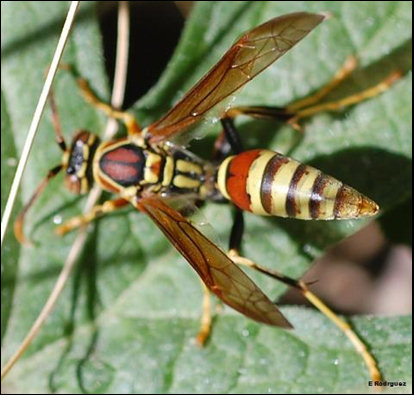 |
TAXONOMY Kingdom Animalia Phylum Arthropoda Class Insecta Order Hymenoptera Family Vespidae Subfamily Vespinae Common Name Paper Wasp |
Identification:
First discoidal cell in fore wing half as long as wing or nearly so.
Middle tibiae with 2 apical spurs.
Yellowjackets have the abdomen banded with black or brown and yellow.
Clypeus broadly truncate and slightly notched at apex. (Borror)
Habitat:
These wasps build nests of a papery material and the tiers of cells are surrounded by an outer covering; some species nest in the ground and others nest above ground in various protected situations. (Borror)
Life history:
Wasps in the family Vespidae revolve around queen and worker castes. The queen and workers can have offspring. Although other female workers can be reproductive the colony revolves around a single queen. The queen uses pheromones to establish dominance and suppress the workers tendency to have offspring. She may also eat the eggs of workers leaving eggs she has laid alone. This behavior ensures her eggs will mature and be fed correctly. (Grewel) Workers can vary in importance, some tending to the young, some forage for food, some are reproductive, and some aiding in defense. Together they function as a unit to make the colony more successful. The main food source of paper wasps is nectar. Feeding plays an important role in pollination of many plants, ensuring plant survival. Paper wasps also catch caterpillars to feed to their young. The nest contains a nursery where one larva is kept in each cell. Cells are capped and pupate to form the adult paper wasp. Most paper wasps die in the winter but some hibernate to emerge in the spring. (Carter)
Importance:
Paper wasps will construct their nests within close proximity of human residences. Even though paper wasps are not considered pests, people are generally fearful and annoyed by them. Paper wasps do possess stingers but only use them in case of provocation (Meyer). However, paper wasps are very important for two reasons. First, they are important in the pollination process. Secondly, people can are allergic to paper wasps stings. If someone is stung by a paper wasp and they exhibit an allergic reaction, those allergic reactions may include rash, difficulty breathing, and drop in blood pressure just to name a few symptoms. It is very important to seek medical attention as soon as possible (Reed).
Borror, Donald J., and Dwight, M. Delong. 1970. An introduction to the study of insects, 3rd ed. Holt, Rinehart and Winston, New York.
Borror, Donald J., and White, Richard E. 1970. A Field Guide to Insects America north of Mexico. Houghton Mifflin Company, Boston.
Carter, Julia. Common Paper Wasps. Retrieved 4 November 2007 http://www.csiro.au/resources/ps1lp.html.
Grewal, K. 2002. "Polistes fuscatus" (On-line), Animal Diversity Web. Accessed 4 November 2007 at http://animaldiversity.ummz.umich.edu/site/accounts/information/Polistes_fuscatus.html.
Meyer, John R. 2005. "Hymenoptera". Accessed 5 November 2007. http://www.cals.ncsu.edu/course/ent425/compendium/ants.html.
Reed, Hal C. "Paper Wasps, Yellowjackets, and Other Stinging Wasps" (On-line). OSU website. Accessed 5 November 2007 at http://pods.dasnr.okstate.edu/docushare/dsweb/Get/Document-2284/F-7305webcolor.pdf.